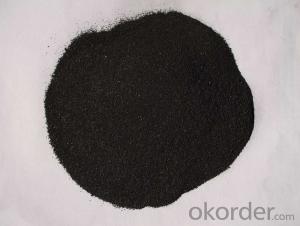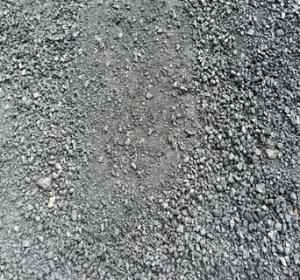Gas Calcined anthracite coal used for carbon increasing
- Loading Port:
- Tianjin
- Payment Terms:
- TT OR LC
- Min Order Qty:
- 19.1
- Supply Capability:
- 991 m.t./month
OKorder Service Pledge
OKorder Financial Service
You Might Also Like
Introduction:
Calcined anthracite can be called carbon additive, carbon raiser, recarburizer, injection coke, charging coke, gas calcined anthracite.It is playing more and more important role in the industry
Best quality Anthracite as raw materials through high temperature calcined at over 2000℃ by the DC electric calciner with results in eliminating the moisture and volatile matter from Anthracite efficiently, improving the density and the electric conductivity and strengthening the mechanical strength and anti-oxidation. It has good characteristics with low ash, low resistivity, low sulphur, high carbon and high density. It is the best material for high quality carbon products. It is used as carbon additive in steel industry or fuel.
Features:
G-High Calcined Anthracite is produced when Anthracite is calcined under the temperature of 1240°C in vertical shaft furnaces. G-High Calcined Anthracite is mainly used in electric steel ovens, water filtering, rust removal in shipbuilding and production of carbon material. We like to you to visit our company
Specifications:
F.C.% | 95MIN | 94MIN | 93MIN | 92MIN | 90MIN | 85MIN | 84MIN |
ASH % | 4MAX | 5MAX | 6 MAX | 6.5MAX | 8.5MAX | 12MAX | 13MAX |
V.M.% | 1 MAX | 1MAX | 1.0MAX | 1.5MAX | 1.5MAX | 3 MAX | 3 MAX |
SULFUR % | 0.3MAX | 0.3MAX | 0.3MAX | 0.35MAX | 0.35MAX | 0.5MAX | 0.5MAX |
MOISTURE % | 0.5MAX | 0.5MAX | 0.5MAX | 0.5MAX | 0.5MAX | 1MAX | 1MAX |
Pictures




FAQ:
Packing:
(1). Waterproof jumbo bags: 800kgs~1100kgs/ bag according to different grain sizes;
(2). Waterproof PP woven bags / Paper bags: 5kg / 7.5kg / 12.5kg / 20kg / 25kg / 30kg / 50kg small bags;
(3). Small bags into jumbo bags: waterproof PP woven bags / paper bags in 800kg ~1100kg jumbo bags.
Payment terms
20% down payment and 80% against copy of B/L.
Workable LC at sight,
- Q: Well, recently, the carbon cycle has suddenly come up with a lot of questions. What's the definition of carbon and light carbon? What are the characteristics, and what are the differences between the two?
- The organic matter is composed of recombinant LFOM was completely decomposed residue or, to re synthesis of aromatic substances as the main organic matter (mainly humus), its stable structure is complex, in fact this part of organic matter in soil clay is a combination between, or in the process of the formation of soil aggregates Among the internal organic matter enclosed in aggregates, plays a very important role in maintaining the structure of aggregates, it is difficult to be utilized by microorganisms, soil carbon pool is stable. The content of 2 components of features from a certain extent that the carbon sensitive to climatic and environmental changes of the reaction.
- Q: How about Zonta carbon technology
- Never go, unless you are a bully, and will mix, inside mess
- Q: What are the impacts of carbon emissions on natural disasters?
- Natural disasters are significantly worsened by carbon emissions, leading to increased frequency and intensity. Carbon emissions have a major effect on global warming and climate change, as they cause the Earth's temperature to rise by trapping heat in the atmosphere. This temperature increase results in various weather pattern changes, which ultimately increase the occurrence and severity of natural disasters. One of the most evident consequences of carbon emissions on natural disasters is the stronger and more destructive hurricanes and tropical storms. These storms gain more energy from warmer ocean temperatures, making them more powerful. Additionally, higher temperatures lead to increased evaporation, resulting in heavier rainfall during storms and a higher risk of flooding and landslides. Carbon emissions also contribute to the melting of glaciers and polar ice caps, causing sea levels to rise. This rise in sea levels makes coastal areas more susceptible to storm surges and flooding during hurricanes and typhoons. Low-lying regions and island nations are particularly vulnerable, as they face the potential loss of their land due to rising waters. Moreover, carbon emissions play a role in the occurrence and severity of wildfires. Rising temperatures dry out vegetation, creating ideal conditions for wildfires to ignite and spread rapidly. These wildfires can devastate large areas of land, destroying ecosystems, homes, and livelihoods. Another consequence of carbon emissions on natural disasters is the disturbance of weather patterns. Climate change alters rainfall patterns, leading to longer and more severe droughts in some regions and more frequent and intense rainfall events in others. These changes in precipitation patterns can result in prolonged droughts, water scarcity, and a higher risk of wildfires in some areas, while others face increased flooding and landslides. In conclusion, carbon emissions have a profound impact on natural disasters. They contribute to global warming and climate change, intensify hurricanes, increase the risk of flooding, raise sea levels, fuel wildfires, and disrupt weather patterns. It is crucial to reduce carbon emissions and transition to clean and sustainable energy sources to mitigate these impacts and protect our planet from the devastating effects of natural disasters.
- Q: What are the effects of carbon emissions on the stability of mountains?
- The stability of mountains is significantly impacted by carbon emissions, leading to various negative consequences. One of the primary effects is the accelerated melting of glaciers and ice caps, caused by global warming resulting from carbon emissions. Rising temperatures cause the ice and snow that hold mountains together to melt, resulting in increased instability. This melting can lead to more frequent and larger avalanches, landslides, and rockfalls, posing a significant threat to human settlements and ecosystems in mountainous areas. Another consequence of carbon emissions on mountain stability is the alteration of precipitation patterns. As the climate changes, rainfall becomes more unpredictable, resulting in a higher frequency of intense rainfall events. This increased rainfall can cause soil erosion and weaken the stability of mountain slopes. The combination of increased erosion and weakened slopes can lead to landslides and other mass movements, further destabilizing mountains. Furthermore, carbon emissions contribute to the acidification of rainwater, which can have detrimental effects on mountain stability. Acid rain erodes rocks and soil, making them more susceptible to weathering processes. This weakening of the geological structure increases the likelihood of landslides and rockfalls. Lastly, carbon emissions also impact mountain stability through their influence on ecosystems and biodiversity in mountainous regions. Climate change caused by carbon emissions can lead to shifts in ecosystems and biodiversity, affecting the stability and resilience of mountain ecosystems, as well as altering vegetation cover patterns. The loss of vegetation cover, for example, further increases the susceptibility of slopes to erosion and landslides. In conclusion, carbon emissions have a range of negative effects on mountain stability. From accelerated glacier melting to altered precipitation patterns, acid rain, and shifts in ecosystems, these emissions pose a significant threat to the geological and ecological stability of mountains. It is crucial to reduce carbon emissions and address climate change to mitigate these effects and preserve the stability of mountain regions.
- Q: How does carbon dioxide affect textile production?
- Carbon dioxide affects textile production in several ways. Firstly, the production of synthetic fibers such as polyester and nylon, which are widely used in the textile industry, involves the emission of carbon dioxide during the manufacturing process. This contributes to greenhouse gas emissions and climate change. Additionally, carbon dioxide is released during the combustion of fossil fuels used for energy in textile factories. This not only adds to the environmental impact but also affects air quality and human health. Moreover, the dyeing and finishing processes in textile production often require the use of chemicals that emit carbon dioxide when they break down or react with other substances. These emissions further contribute to the carbon footprint of the industry. Overall, carbon dioxide has a significant impact on textile production, primarily through the emissions generated during fiber manufacturing, energy consumption, and chemical usage. Therefore, efforts to reduce carbon dioxide emissions and transition to more sustainable practices are crucial for mitigating the environmental impact of the textile industry.
- Q: How is carbon used in the production of pigments?
- Carbon is commonly used in the production of pigments due to its ability to create vibrant and deep colors. Carbon-based pigments, also known as carbon blacks, are produced by the incomplete combustion of hydrocarbons, such as natural gas or petroleum. The carbon particles produced during this process are then processed and purified to create a fine powder that can be used as a pigment. These carbon-based pigments have a wide range of applications in various industries, including inks, paints, plastics, and cosmetics. In the production of inks, carbon black is often added to improve the color intensity and opacity of the ink. It is also used in the manufacturing of black pigments for paints and coatings, providing a rich and deep black color. Carbon-based pigments are also used in the production of plastics. Adding carbon black to plastic materials can enhance their UV resistance, making them more durable and long-lasting. This is particularly important in outdoor applications where exposure to sunlight can cause fading and degradation. Additionally, carbon-based pigments are commonly used in the cosmetics industry. They are added to various cosmetic products, such as eyeliners, mascaras, and lipsticks, to create intense black or dark shades. Carbon black pigments are preferred in cosmetics due to their stability and ability to deliver consistent color. In conclusion, carbon is widely used in the production of pigments due to its ability to create vibrant and deep colors. Carbon-based pigments find applications in various industries, including inks, paints, plastics, and cosmetics, where they enhance color intensity, provide UV resistance, and deliver rich black shades.
- Q: How is carbon used in the production of textiles?
- Carbon is used in the production of textiles through various processes. For instance, carbon black, a form of carbon, is commonly used as a coloring agent in textile dyes, giving fabrics a wide range of colors. Additionally, carbon fiber, a lightweight and strong material derived from carbon, is used to create high-performance textiles for applications like aerospace, sports equipment, and automotive industries. Carbon-based chemicals are also used in textile manufacturing processes such as dyeing, finishing, and printing.
- Q: Is carbon monoxide good for people?
- But in organ transplant operations, the use of trace amounts of carbon monoxide helps dilate blood vessels and reduce inflammation, thereby increasing the survival rate of transplanted organs. But traditional carbon monoxide inhalation has the risk of poisoning patients and medical staff by accidental inhalation of high doses of carbon monoxide. That's the advantage of CO
- Q: How can carbon capture and storage help reduce greenhouse gas emissions?
- Carbon capture and storage (CCS) can help reduce greenhouse gas emissions by capturing carbon dioxide (CO2) emissions from power plants and industrial facilities before they are released into the atmosphere. This technology allows for the separation and capture of CO2, which can then be transported and stored underground in geological formations. By preventing these emissions from entering the atmosphere, CCS helps to mitigate climate change and reduce the overall concentration of greenhouse gases.
- Q: The same manufacturer of different types of badminton rackets on the logo, but the two materials in the end what is the difference?
- High elasticity, a little toughness, deformation when playing, high steel of steel, no deformation when playing
Send your message to us
Gas Calcined anthracite coal used for carbon increasing
- Loading Port:
- Tianjin
- Payment Terms:
- TT OR LC
- Min Order Qty:
- 19.1
- Supply Capability:
- 991 m.t./month
OKorder Service Pledge
OKorder Financial Service
Similar products
Hot products
Hot Searches


























